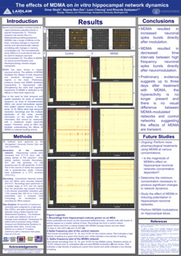Mid Summer Check In
Over the past three weeks, my research project has undergone several changes and adaptations. Initially, my objective was to investigate the effectiveness of a dual chamber multi-electrode array (MEA) developed by our laboratory. This specialized MEA design allowed for the independent development of two neuronal networks, with one side or network being modulated with a drug while the other side or network developed under normal conditions. The primary aim was to study the real-time synchronization changes between the modulated and normal networks through the exchange of media. To facilitate this, we meticulously prepared both the partitioned and normal MEAs through a four-day process involving thorough washing and coating, ensuring a favorable environment for cell growth. Additionally, every Thursday, we conducted dissections of embryonic mouse hippocampi, subjecting the tissue to mechanical and biological digestion to yield a cell solution that was subsequently added to the MEAs.
However, during the second week of the project, we encountered an unexpected setback. When attempting to record signals from all the MEAs, we discovered that our partitioned MEAs lacked the necessary sensitivity to detect spikes from the network. Instead, they only captured low field potentials, which were subsequently filtered out. We speculate that this deficiency in sensitivity may be attributed to the materials used and the fabrication method of the MEAs. Unfortunately, we are unable to address these issues promptly, as the MEAs were produced in collaboration with another lab that will not be able to provide replacement MEAs until after the conclusion of my research period. Consequently, we made the decision to shift our focus towards investigating the relatively understudied pharmacological treatment of MDMA. This compound, with limited prior research on its electrophysiological effects, presented an opportune subject for our study. However, this shift in research direction posed the challenge of developing a new protocol for MDMA modulation, considering the scarcity of existing guidelines. As a preliminary approach, we settled on a concentration of 50 uM, with the intention of conducting further studies in the future using varying concentrations.
With the MEAs and a 50 uM solution of MDMA, we proceeded to modulate one of the neuronal networks and observed changes in synchronization, burst intensity, and inter-burst intervals. Visual analysis revealed noticeable differences; however, further recording sessions in the upcoming weeks are necessary to assess the long-term effects of MDMA. Once sufficient raw data spanning multiple days is obtained, the next step involves processing the data using specialized software to generate raster plots, which will effectively illustrate the MDMA-induced changes in a readily understandable manner.
Moving forward, there are several aspects that still need to be addressed. Firstly, the issue of the sensitivity of the partitioned MEAs requires attention, particularly regarding future experiments or potential modifications to enhance their functionality. Additionally, expanding the study beyond the initial concentration of 50 uM and conducting further investigations with varying concentrations of MDMA would contribute to a more comprehensive understanding of its electrophysiological effects. Furthermore, the long-term effects of MDMA on the neuronal networks need to be thoroughly examined, which necessitates ongoing recording sessions in the coming weeks. Ultimately, the project aims to process the accumulated data into meaningful raster plots, which will serve as a crucial visual representation of the MDMA-induced changes and facilitate the communication of our findings.


Please sign in
If you are a registered user on Laidlaw Scholars Network, please sign in